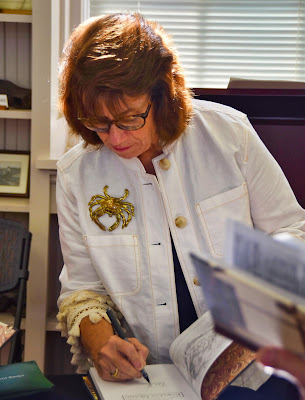Although Kingstree and Williamsburg County escaped Hurricane Florence's wrath, that has not always been the case. In the next two posts we'll look at some of the storms and accompanying floods that have long lived in the memories of Kingstree citizens.
Hurricane Hugo, September 1989
While historians most often write about the October 1893 hurricane which tore through coastal South Carolina, leaving many residents clinging to the treetops in an attempt to save their lives, when Kingstree residents later remembered the great storm of 1893, they were talking about the one that hit on Sunday, August 27. That storm became known as the Great Sea Islands Hurricane, a Catagory 3 storm that made landfall just south of Savannah with winds of 115 miles per hour. The 2,000 deaths attributed to the hurricane were caused largely by the 16-foot storm surge. This storm marked the beginning of the end of the phosphate industry in South Carolina.
In Kingstree, however, preparations were underway for the annual week-long Teachers' Institute, held each summer to bring new methods and information to the county's teachers. The two professors who were to direct the institute arrived that Sunday night in the midst of blinding rain and howling winds. Morning's first light revealed no major property damage or loss of life in Kingstree, but the streets were strewn with fallen trees, and all roads leading into Kingstree were impassable. The professors, realizing that county teachers were unable to get to town, postponed the proceedings until a later date.
Park Avenue, Hurricane Matthew, October 2016
On Monday, September 17, 1906, a Category 1 hurricane made landfall near Georgetown, and moved very slowly northwest, weakening into a tropical storm over Williamsburg County. Property damage in Kingstree was severe. Newspapers reported "wholesale destruction" in the town of Kingstree where buildings were demolished, fences blown away, trees uprooted, and residents suffered heavy losses of livestock. The entire cotton crop was destroyed with some farmers reporting that their cotton plants had been blown out of the ground. Every building in town was reported to have suffered some damage.
Main Street, Hurricane Hugo, September 1989
Louis Stackley was close to completing a handsome, brick store on the corner of Main and Academy streets (just across Academy from the building pictured above). As the winds reached their peak around two o'clock that afternoon, the new building collapsed from their force. A cotton warehouse, also under construction, across the street from the depot fell to the ground, as well, as did three dwellings in various stages of construction. The winds picked up the cotton hull warehouse at the cotton seed oil mill, located where Railroad Auction is today, and hurled it across the railroad tracks. The oil mill itself also suffered serious damage. The roof blew off the courthouse, and the graded school suffered damage, as well.
Main Street, Hurricane Matthew, October 2016
The streets were thickly strewn with debris from buildings and trees. One newspaper account noted, "The staunch oak trees that have for many years shaded the streets and added so materially (to the town) were wrenched from the ground or almost completely dismantled." There was, however, no loss of life in Kingstree, and townspeople began clearing away the debris as soon as the storm subsided.
Third Avenue, Hurricane Hugo, September 1989
In August, 1911, a Catagory 2 storm hit Hilton Head Island, SC, with 100 mile-per-hour winds, sending a significant storm surge up the coast. It destroyed most of South Carolina's rice crop, effectively ending rice production in the state. The storm resulted in 17 deaths, as it pounded the state for three days. The storm made landfall on the 18th anniversary of the Great Sea Islands hurricane of 1893.
Gale force winds began pounding Kingstree on Sunday night, August 27. The high winds lasted all day Monday, with torrents of rain falling all Tuesday, tapering off to showers which lasted until Thursday. While the damage in town was limited to roof damage and fallen fences, about a quarter of the cotton crop was destroyed.
Academy Street, Hurricane Matthew, October 2016
According to The County Record, during the high winds on Monday night, Dr. E.T. Kelley kept hearing a strange moaning sound coming from somewhere in his yard. About 11:30, after he was unable to determine the cause of the sound, he called in his neighbors. A thorough search of his premises found an African-American man hanging by his foot from the fence. The man said he was from Sumter, but had found work in Kingstree as a painter. He said he had gotten drunk and disoriented in the storm, and while trying to climb the fence, his foot got stuck.
The State newspaper, however, printed an entirely different version of the story. In it, W.H. Carr had early that evening heard sounds as if someone were trying to break into his house. He checked all the doors and windows, finding them secure, but later heard groaning outside the house where he found his would-be burglar hanging by his foot from the fence.
Park Avenue, Hurricane Hugo, September 1989
One Kingstree couple barely survived the nightmare of the storm while vacationing on Sullivan's Island. Mr. and Mrs. J.W. Swittenberg moved to a more substantial cottage on Saturday night as it became apparent that the storm would be a bad one. As it turned out, the cottage they evacuated was washed away, taking their luggage with it, while the one to which they moved was partially destroyed. They said it took six men to hold the door to the cottage closed after the wind broke the door fastenings. Despite the heavy rain, the Swittenbergs were able to return to Kingstree on Tuesday with quite a tale to tell.
Gilland Avenue, Hurricane Matthew, October 2016
Next week, we'll look at the devastating floods of 1916 and 1928.



























